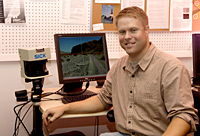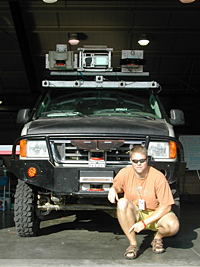

UDaily is produced by the Office of Public Relations
The Academy Building
105 East Main St.
Newark, DE 19716-2701
(302) 831-2791
|
 |
UD computer scientist on robot-race team
Editor’s note: “Alice,” the robot vehicle developed by Team Caltech, of which UD Prof. Christopher Rasmussen was a member, dropped out of the race after it tried to ride over concrete barriers after traveling about 8 miles. Stanford University's robot, a converted VW Touareg sport utility vehicle named Stanley, won the race by navigating the 132-mile course in just under seven hours. For complete details about the outcome of the robot race, visit [www.grandchallenge.org].
 |
| Christopher Rasmussen, UD assistant professor of computer and information sciences |
5:50 p.m., Oct. 6, 2005--Christopher Rasmussen, UD assistant professor of computer and information sciences, is a member of one of 23 teams that will participate in the 2005 DARPA Grand Challenge on Saturday, Oct. 8, in Primm, Nev.
The race, which is sponsored by the Defense Advanced Research Projects Agency (DARPA) of the U.S. Department of Defense, features a prize of $2 million to the first driverless vehicle to finish a grueling desert course up to 175 miles long in less than 10 hours.
Competitors will encounter boulders, cactii, barbed wire fences, water crossings, sheer drops and even human-made obstacles along a course laid out by the sponsor.
Rasmussen is a member of Team Caltech, based at the California Institute of Technology, which will be competing with “Alice,” a 2005 Ford E-350 van fitted with four-wheel-drive, off-road suspension and run-flat tires, as well as computer-controlled steering, acceleration, braking and shifting.
The robot "sees" the world through an array of laser-range sensors and cameras mounted on its roof and front bumper, according to Rasmussen, who joined Team Caltech for the 2004 Grand Challenge, when the team finished in fifth place after making a two-mile trip.
“The terrain was flat and then it went to the hills and then there were switchbacks,” Rasmussen, who is responsible for the visual system, said. “Leaving the road proved more dangerous because the truck got caught on a barbed wire fence. It broke through, wandered around and then tried to come back.”
Rasmussen, of Hockessin, who has been working on the visual system with Thommen Korah, a research assistant in UD’s Department of Computer and Information Sciences, said the robot is a lot smarter this year and barbed wire fences that are practically invisible to the sensors will not get in the way.
“If it stops, and it doesn’t know why it stops, it will try again harder,” he said. “Last year, it didn’t have that kind of reasoning. It doesn’t have common sense; it’s almost like a 2-year-old child. If something new comes along, it doesn’t know what to do. Kids are actually smarter.”
The sensors give the truck the ability to visually recognize and follow back-country roads by finding the vanishing point of any ruts, tire tracks, lane lines and other edges associated with the road and calculating a steering adjustment to keep the vehicle correctly pointed. The system also can detect when the course leaves a road and automatically shift control to additional modules specialized for avoiding rocks, ditches and other hazards.
 |
| Prof. Rasmussen with ‘Alice,’ a driverless, computer-controlled van |
"It will be a historic day," Rasmussen said. "No matter what happens, scientists are going to learn a lot to help drive robotics research forward. I also think that people will be really impressed at how much more artificial intelligence technology can do than just play chess.
“It was pretty hair-raising at first to ride in a car with only a computer program at the wheel, but after a few miles it actually gets a little boring. I'll have mixed feelings watching Alice drive away from the start line alone, but I'm sure the whole team will be hoping it's a long time before we see her again."
The competing robots will start five minutes apart and travel at a maximum speed of 50 mph. The vehicles include Humvees and a variety of sport utility vehicles.
Rasmussen predicted a 50 percent chance that one of the teams will complete the difficult course and that the 7.5 miles traveled by the best team last year might be the worst performance this year.
“It’s fun to get out there in the desert and actually try to do this,” he said. “This is an opportunity to test your algorithims to see what happens and to improve them. It’s a lot of fun to chat with people who have the same obsession as yours.”
Rasmussen said his role on Team Caltech is far more than the fulfillment of a childhood dream. “I always wanted a remote controlled car, but I never did as a child,” he said. “This is like a big toy, and you are the toymaker and player as well.”
Article by Martin Mbugua
Office photo by Kathy F. Atkinson
 E-mail this article
E-mail this article
To learn how to subscribe to UDaily, click here.
|
 |

|

